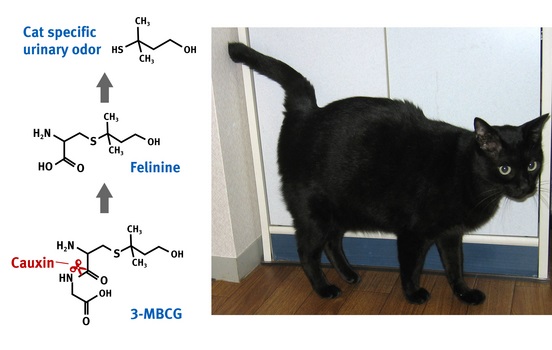Dec. 8, 2006 Research Highlight Biology
How cats produce their distinctive smell
Biochemists unlock the molecular secret to cat odor
 Figure 1: A cat spraying a vertical surface with a fine stream of urine to mark its territory (right), and the biochemical pathway involved (left).
Figure 1: A cat spraying a vertical surface with a fine stream of urine to mark its territory (right), and the biochemical pathway involved (left).
Researchers have uncovered the molecular pathway whereby cats produce the species-, sex- and age-specific compounds with which they mark their territories (Fig. 1). Cats may also use the same substances to identify each other and attract mates.
The work provides significant new information on chemical communication in mammals, and may lead to a practical way of neutralizing the odor of cat urine in domestic environments.
Previous studies showed that felinine, an odorless compound thought to be the precursor of cat pheromones, is present in cat urine. It was believed that felinine was produced from the 3-methylbutanol-glutathione (3-MBG) present in cat’s blood, but the reaction pathway was unknown.
Reporting in Chemistry and Biology 1, biochemists from the RIKEN Frontier Research System in Wako, in collaboration with colleagues from several other institutions, discovered that as well as felinine, there were also high concentrations of a protein component called cauxin in the urine of normal male cats. Cauxin, a member of a group of enzymes that breaks chemical bonds in a variety of organic compounds, is produced only in the kidney of the domestic cat and closely-related species of the cat family.
In the laboratory, the team found that cauxin split 3-methylbutanol-cysteinylglycine (3-MBCG), converted from 3-MBG by an enzyme, into felinine and glycine. The researchers then monitored the levels of cauxin and felinine in the urine of male and female cats over time, and discovered that the two compounds tended to increase in step with each other in cats older than three months. Neither was present in cats younger than two and a half months.
Although felinine is odorless, it develops a smell similar to cat urine when stored at room temperature. When the researchers analyzed volatile compounds from the air above cat urine, they found natural breakdown products of felinine which produced the characteristic odor. These volatile compounds, which vary according to age and sex, may well be the active ingredients in cat chemical communication, the researchers speculate.
Based on this work, the team has suggested ways of eliminating cat odor. One possibility is to block felinine production by adding a cauxin inhibitor to cat food. This would be difficult, says team member Masao Miyazaki. An easier alternative, he says, may be to use compounds containing metal ions, such as gold, silver and copper, which bind to and neutralize felinine derivatives carrying the pungent thiol group.
Miyazaki now wants to investigate the impacts of felinine and its derivatives on cat behavior. “We are looking for pheromonal activity in cats.”
References
- 1. Miyazaki, M., Yamashita, T., Suzuki, Y., Saito, Y., Soeta, S., Taira, H. & Suzuki, A. A major urinary protein of the domestic cat regulates the production of felinine, a putative pheromone precursor. Chemistry and Biology 13, 1071–1079 (2006). doi: 10.1016/j.chembiol.2006.08.013
